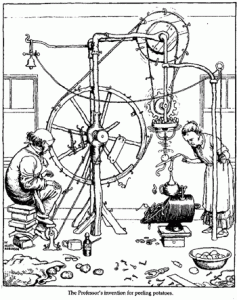It seems that my conversations with others provoke most of my blog posts, and this one will be no exception. This time, the conversation was one of those you generally have over a beer. It begins by posing a theoretical question that invites pontificating. I frequently resort to this ploy in social settings in order to engage the other person in something other than small talk. And since pontificating is one of the things I do best, I really enjoy these discussions.
The question for debate on this occasion was, “What are the three most important factors in [blank]?” Where [blank] is your particular profession/art form. It’s always fascinating to hear what people say in response to this question because very often, nobody ever asks them. Most people just go about doing [blank], and the consumer(s) of their work product are either satisfied, or dissatisfied. The consumer rarely gives a happy rat’s ass about the process involved, which is a shame because a basic understanding of the process always adds value to the final product. Or at the very least, provides a context for the result.
Let me give you an example…
My paternal grandfather was a cabinetmaker. Our family is lucky enough to have several of his pieces in our homes (I have a lovely little game table). Undoubtedly, the pieces are beautiful in their own right, but if you knew how many hours of intricate work went into their assembly and finishing, you’d be amazed. That makes the piece all the more valuable.
This is also the case in a more strictly “work-related” context. I have a friend who does sophisticated computer performance analysis for a large bank. The work product in this case is often a recommendation for tuning or optimizing capacity. The recommendation may be a few paragraphs in an email, or a twenty-minute conference call. What the consumer doesn’t ever see are all the hours spent poring over data, which when coupled with years and years of learning the intricacies of operating systems and computer architecture, allows a viable, actionable recommendation to emerge.
So back to the discussion: My conversation partner this time is a kitchen and bath designer. She creates rooms of custom cabinetry with all the attendant appliances, fixtures, and so on for people’s homes. There is a tremendous amount of work involved in taking a homeowner’s daydream and realizing it in their actual house, something the homeowner has no clue about, or for that matter, a spare rodent posterior to give. When I posed the question, she answered that the three most important factors in her work were family dynamics, personalization, and practicality. Family dynamics relates to how people actually “live” in their house; how they use it. Personalization deals with incorporating the family’s tastes, possessions, and aesthetics into the space to make it their own and not look, as she colorfully put it, “like someone threw up a Crate ‘n Barrel catalog all over the place.” Finally, practicality deals with the physical functioning of the space. I won’t relate her epithet-laden rant about pot-fillers here, but you get the idea.
Thinking about the question as a writer, I believe story, character, and pacing would be my answer. In the case of fiction, obviously the story is paramount. Is it something that engages people and draws them into your imaginary world? Propping up the story are characters: believable, relatable characters, who speak in an authentic voice. Nothing is more jarring when reading an otherwise good story than running into anachronistic words or dialogue. It’s doubtful that people in Europe in the Middle Ages—just to pick a setting at random—would ever utter something like, “Man this plague is a bitch, Holmes!” Lastly, pacing is important. As I write, I struggle to maintain a brisk pace in the story without breezing past important plot developments. Going too fast is as bad as moving too slowly. The latter puts the reader to sleep while the former leaves them scratching their heads saying, “Huh?”
So what about you? What do you do and what are the most important factors in doing it? Have you ever thought about it? Feel free to grab a cocktail and share with the class in the comments.

